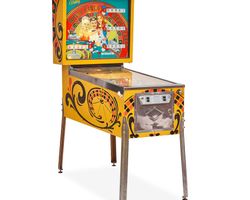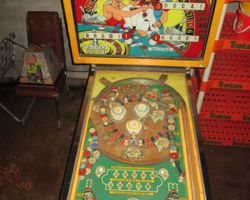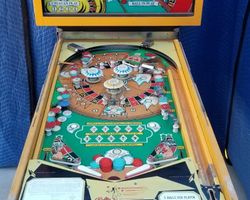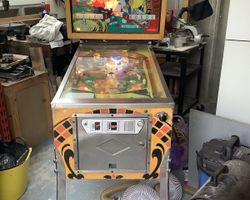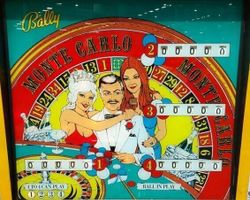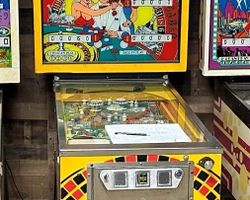Monte Carlo
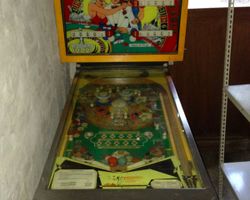
Average Prices: USD $300 to $900
Produced: March, 1973
Production Run: 5,254 units
Machine Type: Electro-mechanical
Players: 4
Design by: Jim Patla
Art by: Dave Christensen
"Monte Carlo" by Bally Manufacturing Corporation, launched in March 1973, stands as a notable electro-mechanical (EM) pinball machine from an era defined by mechanical ingenuity and vibrant artistry. Designed by Jim Patla with artwork by Dave Christensen, this four-player machine immerses players in a captivating casino environment, drawing clear inspiration from the classic game of roulette. Bally produced 5,254 units of "Monte Carlo," a substantial run that speaks to its appeal upon release. A distinctive aspect of its lineage is its direct relationship with Bally's single-player title, "Odds & Evens," released in the same year; "Monte Carlo" essentially offered the same gameplay experience but adapted for multi-player competition. This strategic approach by Bally allowed them to leverage a successful design across different market segments, providing both solo and competitive experiences based on a strong core concept. The machine’s release marked a period when EM games were reaching their zenith before the eventual shift towards solid-state technology.
Signature Features and Design
"Monte Carlo" distinguishes itself through a seamless integration of its casino theme, both visually and mechanically. Dave Christensen's artwork is a primary draw, featuring a rich palette and detailed illustrations that capture the allure of a high-stakes gambling hall. The playfield showcases a natural wood grain aesthetic, complemented by vibrant colors for targets and inserts, enhancing the feeling of a refined gaming table. Central to its design are the ten mini-rollover buttons, visually resembling poker chips, spread across the upper playfield. These "chips" are crucial for advancing gameplay, requiring players to light either "odd" or "even" numbers, directly echoing the roulette concept.
Beyond the aesthetic, "Monte Carlo" incorporates several mechanical elements that enhance the experience. Two kick-out holes serve as significant objectives, often rewarding points or advancing game features. Three pop bumpers, positioned strategically, provide energetic ball deflection, keeping the playfield alive. The inclusion of two mushroom bumpers, which when hit can open gates, adds a layer of strategic depth, allowing for controlled shots or access to high-scoring areas. An up-post between the flippers offers a momentary save mechanism, a common but welcome feature in many EM designs, providing a brief reprieve from an otherwise challenging outlane situation. These elements collectively contribute to a cohesive experience, tying the visual theme directly into the pinball action.
Playfield and Mechanics
The "Monte Carlo" playfield is structured to challenge players with precise shots and reward strategic ball control. At the bottom, two strong flippers provide the primary means of interaction. Above them, two slingshots are positioned to direct the ball back into play with force, often leading to unpredictable trajectories. The central area of the playfield is dominated by two kick-out holes and an array of scoring targets.
The objective revolves around lighting the "odd" and "even" numbers represented by the ten mini-rollover buttons scattered across the upper portion of the playfield. Achieving this often requires deliberate shots or skilled nudging to guide the ball through specific pathways. Two side ramps, while challenging to hit intentionally, can provide momentum and potentially lead to the upper playfield targets. The two mushroom bumpers, located in the upper-mid playfield, play a role in opening a strategically important upper gate, granting temporary access to higher scoring opportunities or easier paths to the rollover buttons. The lighting scheme on the playfield reinforces the roulette theme, with "odd" and "even" numbers illuminating as they are activated, creating a visually satisfying progression towards bonus awards. The detailed artwork on the playfield, featuring roulette wheels and card game elements, further immerses the player, making each shot feel like a gamble at the table.
Gameplay Dynamics
"Monte Carlo" offers a deceptively simple yet profoundly challenging gameplay loop centered on its "odds and evens" objective. The core progression involves lighting either all the "odd" numbered rollover buttons or all the "even" numbered ones to unlock significant bonuses, extra balls, or specials. This requires multiple trips to the upper playfield and precise aiming to activate individual targets. The scoring system rewards both direct hits and strategic completion of objectives, with a maximum displayed score of 199,990 points per player.
The game's difficulty is a defining characteristic. Many shots require accuracy, and the playfield design, particularly the wide outlanes and aggressive slingshots, often funnels the ball towards drains. This demands a high degree of skillful nudging to keep the ball in play and direct it towards desired targets. The center saucer, a prominent feature, is a focal point of both reward and risk. While it can offer substantial points (5,000 when lit) or advance game features, shots into it are often described as finicky, sometimes leading to unpredictable kick-outs that can result in immediate drains if not carefully managed.
"Monte Carlo" also includes a notable configuration option: a jumper plug inside the cabinet can alter how the rollover numbers are lit. This allows operators or home owners to set the game to light numbers individually or in pairs, significantly impacting the game's difficulty and scoring potential. This hidden customization detail can lead to vastly different gameplay experiences, explaining variations in high scores and perceptions of the game's challenge. Successful play often involves prioritizing which number sets to pursue, strategically using the kick-out holes for bonus accumulation, and mastering the art of the nudge to navigate the demanding playfield.
Reception and Legacy
"Monte Carlo" has garnered a consistently positive reception within the pinball community, often celebrated as a prime example of an engaging electro-mechanical machine. Its strengths are frequently attributed to the compelling integration of the roulette theme, which is visually and mechanically woven into every aspect of the game. Dave Christensen's artwork is a standout feature, praised for its attractive, detailed, and vibrant presentation, contributing significantly to the machine's aesthetic appeal.
Players frequently highlight the machine's challenging gameplay as a major draw. The need for precise shots and the aggressive nature of the slingshots, coupled with wide outlanes, create a demanding experience that rewards skillful nudging. This aspect is often cited as a positive, with players noting that "Monte Carlo" can sharpen one's nudging abilities. The game’s layout is generally well-regarded, offering a variety of shots and objectives that maintain player interest over multiple plays. The satisfaction of lighting the "odds" or "evens" and unlocking bonuses provides a clear sense of progression.
However, the machine is not without its specific criticisms. The wide outlanes are a common point of contention, leading to what some describe as a "drainer" experience. The center saucer, while a high-scoring target, can be unpredictable upon eject, sometimes sending the ball directly into an outlane, a source of frustration for players. The difficulty in intentionally hitting the side ramps is also noted. Despite these challenges, many pinball enthusiasts consider "Monte Carlo" a "keeper" for home collections, appreciating its depth and replayability. Its reputation endures as a well-designed EM game that effectively leverages its theme to create a challenging and rewarding pinball experience, solidifying its place as a recognized title from Bally's prolific EM era.
Sponsored Links
 Ebay Listings
Ebay Listings
 Auction Results
Auction Results
| Cost | Location | Date |
|---|---|---|
| GBP £599 |  Ashford, United Kingdom Ashford, United Kingdom |
01 November, 2024 |
| GBP £599 |  Ashford, United Kingdom Ashford, United Kingdom |
07 October, 2024 |
| USD $5,000 |  California, United States California, United States |
10 September, 2024 |
| GBP £800 |  United Kingdom United Kingdom |
14 February, 2024 |
| USD $780 |  California, United States California, United States |
03 February, 2024 |
| USD $1,000 |  California, United States California, United States |
06 July, 2023 |
| USD $2,450 |  California, United States California, United States |
27 October, 2022 |
| AUD $3,900 |  New South Wales, Australia New South Wales, Australia |
18 August, 2022 |
| USD $999 |  United States United States |
08 April, 2021 |
| EUR €659 |  Rheinland-Pfalz, Germany Rheinland-Pfalz, Germany |
08 March, 2021 |


Private Policy · Search Website · Contact Us
As an eBay Partner, we may earn a commission from qualifying purchases made through links on this site, at no additional cost to you.
All trademarks and copyrighted materials remain property of their respective owners. All other content copyright 2007 - 2026 Pinpedia.

